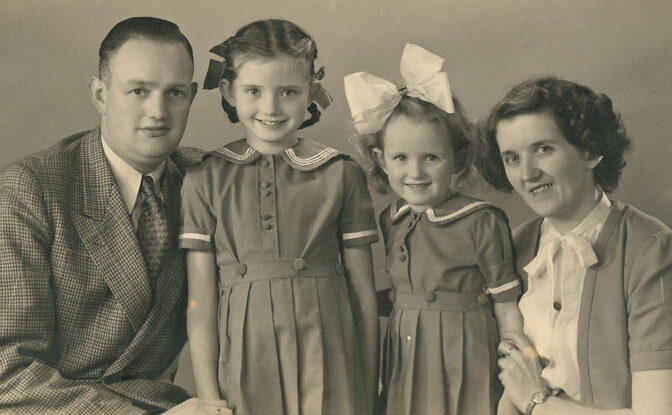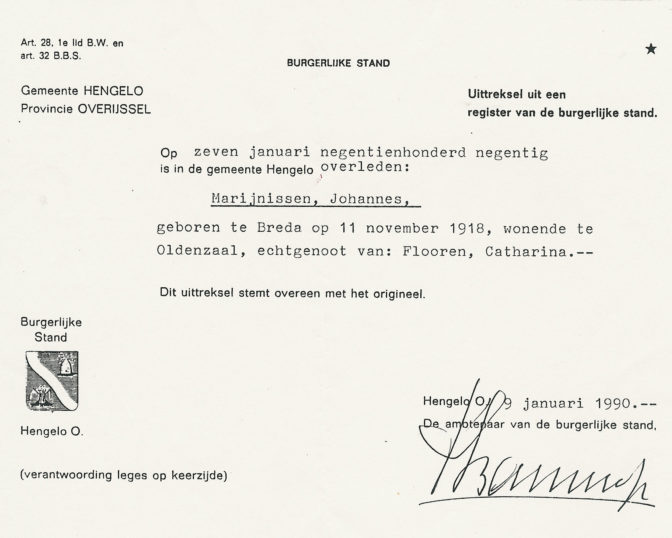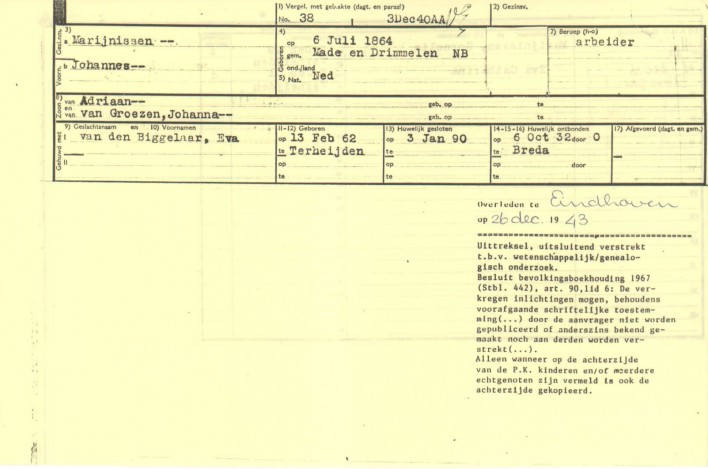In my Level-Up Challenge, I defined six levels of ancestral profiles. In this post, I will give you a basic research plan for an ancestor living in the 20th century for levels 1-4.
Level 1: Names only
I usually find the name of the person in records of somebody else I am researching. No specific research plan needed.

Jan Marijnissen and Toos Flooren with their daughters, 1951. Family photo, orphaned work
Level 2: Vital statistics
- Birth record. Birth records are public after 100 years.
- Marriage record. Marriage records are public after 75 years.
- Death record. Death records are public after 50 years.
If the records are not public yet, it may be possible to order certified copies in some cases. If I cannot get a certified copy, I try to find the announcements in newspapers, prayer cards, or family papers, or order a personal record card. See the level 2 checklist for more ideas.

Certified extract of death record of Johannes Marijnissen
Level 3: Occupations, residence, children, spouses
The vital records will already have given me the names of their spouses and occupations and place of residence at the time of marriage and death.
- Population registers for people born before 1939 (registers or family cards) and personal records for people who died in the Netherlands after 1939. This will give me addresses where they lived, various occupations, and the names of children and spouses.
- Address books and phone books. Often available via Delpher or the local or regional archives.
- Birth, marriage, and death records of the children and spouses (see level 2). I research all the children and spouses at least at level 2 but that is a personal preference.
See the level 3 checklist for more ideas.

Personal record card of Johannes Marijnissen (grandfather of the Johannes mentioned above)
Level 4: Property ownership, military service, religion, criminal activity
The population register should already have given me the religion.
- Death duties files (until 1928).
- Notarial records. Public after 75 years.
- Cadastral records. These are available via the Kadaster website but it requires a subscription. Also available in reading rooms of many archives in the Netherlands.
- Marriage supplements. They are public after 75 years.
- Military service records. Records up to 1924 are at the National Archives. More recent records are now destroyed 100 years after the birth of the soldier except in rare circumstances so order them as soon as possible. Records of living people can only be ordered by the people themselves. Records of deceased people born less than 100 years ago need proof of death to order from the Department of Defense.
- Prison records. Public after 75 years. Not indexed for most prisons.
- Criminal court records. Public after 75 years. Not indexed for most courts.
- Central Archives of Criminal Jurisdiction to see if they were suspected of collaboration in World War II. These records are not public until 2025. You can ask the National Archives if there is a file.
- Newspapers and magazines (including trade journals).
- Prayer cards.
See the level 4 checklist for more ideas.

Prayer card of Johanna Buis
Level 5
At level 5, I consult records that will give me a deeper understanding of my ancestors’ lives. These are often triggered by discoveries during the level 1-4 research and differ greatly from one ancestor to the next, so there is no generic research plan I follow.
Some examples:
- I research the history of the towns where they lived to get an understanding of what life would be like. If possible, I try to find old photos, videos, and maps.
- I would research the houses where they lived, trying to find contemporary photos or maps.
- I would try to find employment records and pension records. These can be available for civil servants, railroad employees, sometimes for teachers, etc.
- If they owned a business, I would look for ads in newspapers and magazines, mentions in address books, business records that may survive in archives, bankruptcy records in the archives of courts, etc.
- I would research their employers, trying to find photos or a history of the firm.
- If they were in the army or navy, I would research their unit and/or ship.
- I would check for school records if these have been preserved.
- Sometimes, the marriage record will indicate that the couple had dispensation to marry, as in the case of my great-grandparents’ marriage. Or I may find a reference to a royal decree in a newspaper or personnel file. In that case, I will obtain the royal decree from the National Archives.
- I would find court records for guardianship appointments of people who lost their parents before they were adults.
Other tips
See also tips for researching people in the 1900s.
Examples of 20th century research:
- Was Eleanor of Aquitaine my ancestor? Generation 3 – Johannes Marijnissen. Includes military service record.
- Was Eleanor of Aquitaine my ancestor? Generation 4 – Cornelia Francisca van den Heuvel. Includes population registers.
- Was Eleanor of Aquitaine my ancestor? Generation 5 – Gerardus van den Heuvel. Includes criminal records.

